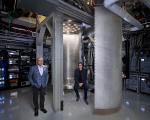Asset gallery
Media assets are free for editorial broadcast, print, and online use. It is restricted for use for other purposes.
-
Download: Hi Res (1.2 MB)
The SUNY Polytechnic Institute Colleges of Nanoscale Science and Engineering’s NanoTech Complex in Albany, NY is an example of where semiconductors are produced and photoresist materials are used. (Photo credit: Connie Zhou)
-
Download: Hi Res (551 KB)
In the next five years, we aim to help facilitate the generation of treatments to aid physicians and front-line workers in combating novel, life-threatening viruses on a larger scale than is currently possible. A combination of AI, analytics and data can potentially help with the rapid analysis of real-world medical evidence to suggest new candidates for drug repurposing and speed clinical trials. In the future, these tools may reach widespread adoption across industries, effectively becoming one of the means of rapidly responding to global, life-threatening viruses.
-
Download: Hi Res (6.1 MB)
The convergence of emerging technologies allows us to address the discovery process in a fundamentally new way. Once labelled promising but distant, quantum computers are developing steadily and show potential to simulate complex molecules on the fly, accurately and rapidly predicting the outcome of chemical reactions and helping us discover entirely new classes of materials.
Photo taken at 2018 ASCE (Credit: Graham Carlow)
-
Download: Hi Res (806 KB)
The convergence of emerging technologies allows us to address the discovery process in a fundamentally new way. AI and quantum will increasingly combine with rapidly-advancing high-performance classical computers as a platform for scientific discovery.
The IBM-built Summit supercomputer pictured here is the world's smartest and most powerful supercomputer. (Photo Credit: ORNL)
-
Download: Hi Res (3.5 MB)
IBM designed an approach to accelerate material discovery where AI is a key component across the entire chain of the material discovery process. This includes its cloud-powered chemistry lab RoboRXN, which allows researchers to create new materials by predicting the outcome of chemical reactions. Since earlier this year IBM scientists around the world are using RoboRXN to synthesize materials for carbon capture, photoresists and antivirals. It will soon go to work generating materials for nitrogen fixation.
-
Download: Hi Res (2.5 MB)
The hybrid cloud will enable a flexible infrastructure of emerging technologies to supercharge the discovery of materials, some of which we haven’t imagined yet.
Inside the IBM Cloud in Dallas, Texas. (Credit: Connie Zhou for IBM)
-
Download: Hi Res (4 MB)
IBM Chief Executive Officer Arvind Krishna (left) and Director of IBM Research Dario Gil are pictured with a 10-foot-tall and 6-foot-wide "super-fridge,” a dilution refrigerator larger than any commercially available. The “super-fridge” is being custom built by IBM to effectively support quantum systems as they scale to the thousands and eventually million-plus qubit systems of the future that will be capable of solving problems out of reach of today’s most powerful supercomputers (Credit: Connie Zhou for IBM)
-
Download: Hi Res (2.6 MB)
IBM Chief Executive Officer Arvind Krishna (left) and Director of IBM Research Dario Gil are pictured with a 10-foot-tall and 6-foot-wide "super-fridge,” a dilution refrigerator larger than any commercially available. The “super-fridge” is being custom built by IBM to effectively support quantum systems as they scale to the thousands and eventually million-plus qubit systems of the future that will be capable of solving problems out of reach of today’s most powerful supercomputers (Credit: Connie Zhou for IBM)
-
Download: Hi Res (1.9 MB)
:IBM Chief Executive Officer Arvind Krishna (left) and Director of IBM Research Dario Gil are pictured with a 10-foot-tall and 6-foot-wide "super-fridge,” a dilution refrigerator larger than any commercially available. The “super-fridge” is being custom built by IBM to effectively support quantum systems as they scale to the thousands and eventually million-plus qubit systems of the future that will be capable of solving problems out of reach of today’s most powerful supercomputers.
Credit: Connie Zhou for IBM -
Download: Hi Res (1.7 MB)
IBM Quantum Hummingbird is a 65-qubit processor available on the IBM Cloud for members of the IBM Q Network. Quantum processors rely on the mathematics of elementary particles in order to expand computational capabilities, running quantum circuits rather than the logic circuits of digital computers.
Credit: Connie Zhou for IBM








